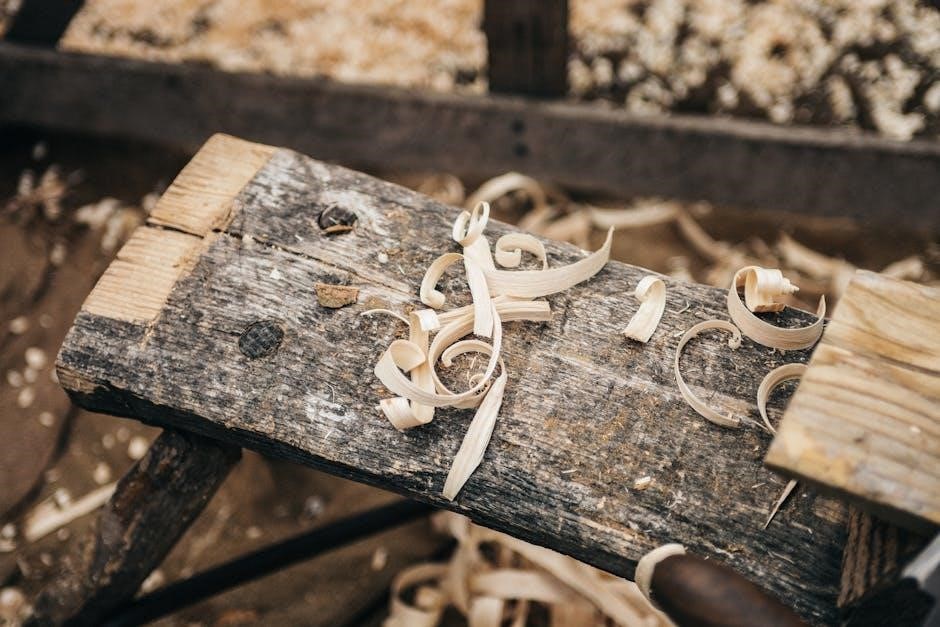A reciprocating saw guide block is a crucial component that enhances precision and stability during cutting tasks. It ensures consistent blade alignment, reducing vibrations and improving overall tool performance. Designed to accommodate various blade types and materials, guide blocks are essential for professionals and DIYers seeking accuracy and efficiency in woodworking, metalworking, and demolition projects. This guide explores their design, functionality, and benefits in detail.
Overview of Reciprocating Saws and Their Components
A reciprocating saw operates with a back-and-forth blade motion, ideal for demolition, pruning, and cutting various materials. Key components include the motor, blade, shoe, and handle. The motor drives the blade, while the shoe stabilizes the tool during use. These saws are versatile, accommodating different blade types for wood, metal, or plastic cutting, making them essential for professionals and DIY enthusiasts alike.
Importance of the Guide Block in Reciprocating Saws
The guide block is essential for maintaining blade alignment and stability, ensuring precise cuts. It reduces vibration, prolongs tool life, and enhances user control. By minimizing blade deflection, it improves cutting accuracy and efficiency, making it indispensable for professionals and DIYers tackling demanding projects in woodworking, metalworking, and demolition.
Evolution of Guide Block Design and Technology
Guide blocks have evolved significantly, from basic metal frames to advanced designs incorporating durable materials and adjustable features. Modern versions utilize high-strength alloys and ergonomic designs for better performance. Innovations like self-lubricating systems and quick-adjust mechanisms enhance functionality, ensuring compatibility with various blades and improving efficiency across different applications.

Design and Construction of Reciprocating Saw Guide Blocks
Guide blocks are crafted from durable materials like aluminum or steel, ensuring strength and precision. Their design includes alignment systems and adjustable features, enhancing stability and cutting accuracy across various applications.
Materials Used in Guide Block Manufacturing
Guide blocks are typically made from durable materials such as high-strength aluminum, steel, or advanced polymers. Aluminum offers lightweight durability, while steel provides maximum rigidity. Some blocks may incorporate heat-resistant coatings or composite materials for enhanced performance. These materials ensure longevity, precision, and stability, making them suitable for heavy-duty applications in various industries.
Key Features of Modern Guide Blocks
Modern guide blocks feature adjustable alignment systems, allowing users to customize fit for different blades and materials. They often include anti-vibration dampeners and quick-release mechanisms for easy installation. High-precision engineering ensures minimal blade deflection, while durable construction withstands harsh environments. Some models offer integrated lubrication systems to reduce friction and extend tool life, enhancing overall cutting efficiency and user experience.
How Guide Blocks Enhance Cutting Precision
Guide blocks enhance cutting precision by maintaining consistent blade alignment and minimizing deflection. They stabilize the reciprocating motion, ensuring straighter cuts and reduced wobble. This results in cleaner, more accurate finishes, especially in demanding materials like metal or thick wood. By controlling blade movement, guide blocks reduce the risk of uneven cuts, providing users with greater control and precision during operation.

Types of Reciprocating Saw Guide Blocks
Guide blocks are available in fixed, adjustable, and specialized designs, catering to specific materials and tasks. Fixed blocks offer stability, while adjustable ones provide versatility for various projects, ensuring precise cuts across different applications.
Fixed vs. Adjustable Guide Blocks
Fixed guide blocks provide consistent stability and are ideal for repetitive cuts, while adjustable versions offer flexibility, allowing customization for different blade widths and materials. Adjustable blocks are preferred for versatile projects, ensuring precise alignment without frequent recalibration. Both types enhance tool performance but cater to different user needs and applications.
Specialized Guide Blocks for Different Materials
Specialized guide blocks are tailored for specific materials, ensuring optimal performance. For woodworking, they minimize splintering, while metalworking blocks reduce blade deflection. Plastic and PVC guides prevent melting, and demolition blocks enhance durability for tough tasks. Each design addresses unique challenges, offering precision and efficiency across diverse applications, making them indispensable for professionals handling varied projects and materials.
Aftermarket vs. OEM Guide Blocks
Aftermarket guide blocks offer cost-effective alternatives to OEM parts, often matching quality and performance. OEM blocks ensure precise fitment and durability, made by the original manufacturer. Aftermarket options may vary in material quality but provide budget-friendly solutions. Choosing between them depends on priorities like cost, tool longevity, and brand loyalty, allowing users to balance affordability with performance and reliability.

Advantages of Using a Reciprocating Saw Guide Block
A guide block enhances cutting precision, reduces blade deflection, and minimizes vibration, improving control and accuracy. It also prolongs tool and blade life, ensuring smoother operations.
Improved Accuracy in Cutting
A guide block ensures precise blade alignment, reducing deflection and vibration. This stability allows for straighter, cleaner cuts, minimizing waste and enhancing overall cutting efficiency. By maintaining consistent control, it is particularly beneficial for intricate cuts in wood, metal, and plastic pipes, making it indispensable for professionals and DIYers seeking professional-grade results in various projects.
Reduced Vibration and Fatigue
A guide block significantly reduces vibration during operation, minimizing user fatigue. By stabilizing the blade and absorbing shocks, it allows for smoother cuts and better control. This feature is especially beneficial for extended use, as it reduces strain on the operator’s hands and arms, making it ideal for professionals and DIYers working on demanding projects.
Extended Tool and Blade Life
A guide block ensures proper blade alignment, reducing friction during cuts and extending blade life. By minimizing stress on the tool’s motor, it prolongs the overall lifespan of the reciprocating saw, benefiting both professionals and DIY enthusiasts by reducing maintenance and replacement costs.
Common Applications of Reciprocating Saw Guide Blocks
Reciprocating saw guide blocks are widely used in woodworking, metalworking, demolition, and plumbing, ensuring precise cuts and enhanced tool performance across various materials and tasks.
Woodworking and Carpentry
In woodworking and carpentry, reciprocating saw guide blocks are essential for making precise cuts in wood. They help in maintaining straight lines and consistent depths, especially when cutting through thick lumber or intricate designs. This accuracy is crucial for projects like furniture making, where fit and finish are paramount. The guide block’s stability ensures minimal waste and professional-grade results.
Metalworking and Demolition
In metalworking and demolition, reciprocating saw guide blocks play a vital role in handling tough materials like steel pipes and metal sheets. They provide the necessary rigidity to maintain precise cuts, even through thick or hardened materials. This is especially important in demolition tasks, where accuracy and control are critical to safely dismantle structures without causing unintended damage or hazards.
Plumbing and Pipe Fitting
In plumbing and pipe fitting, reciprocating saw guide blocks are indispensable for precise cuts in various pipe materials, including PVC, copper, and steel. The guide block ensures straight, clean cuts, reducing the risk of pipe damage and leaks. This level of accuracy is crucial for maintaining the integrity of plumbing systems and ensuring professional-grade results in every installation or repair project.

Maintenance and Troubleshooting
Regular cleaning and lubrication of the guide block are essential for optimal performance. Troubleshooting common issues like misalignment or wear ensures extended tool life and accuracy.
Cleaning and Lubricating the Guide Block
Regularly clean the guide block with compressed air to remove dust and debris. Use a soft brush to wipe away stubborn particles. Apply a small amount of silicone-based lubricant to moving parts to reduce friction and wear. Avoid using heavy oils, as they can attract dust. Proper maintenance ensures smooth operation, extended tool life, and consistent cutting performance.
Common Issues and Their Solutions
Common issues with guide blocks include blade misalignment, excessive wear, and vibration. To address these, adjust or replace the guide block if misaligned. Lubricate moving parts regularly to reduce friction. Inspect for wear and tear, replacing damaged components promptly. Tighten loose parts and ensure proper tool balance to minimize vibration. Regular maintenance helps prevent these issues and extends the guide block’s lifespan.
When to Replace the Guide Block
Replace the guide block when it shows significant wear, such as deep scratches or misalignment grooves. If the block is loose, warped, or corroded, replacement is necessary. Additionally, if the blade wobbles excessively or cutting precision decreases, it’s time to install a new guide block to maintain optimal performance and safety. Regular inspections help determine when replacement is needed.

Comparative Analysis of Guide Blocks from Leading Brands
Leading brands like DeWalt, Milwaukee, and Bosch offer high-quality guide blocks, each excelling in durability, precision, and innovation. Comparative analysis reveals differences in design, material, and performance, helping users choose the best option for their needs.
Dewalt vs. Milwaukee Guide Blocks
Dewalt and Milwaukee guide blocks are top choices among professionals, offering exceptional durability and precision. Dewalt guide blocks are known for their robust construction and versatility, making them ideal for heavy-duty applications. Milwaukee, on the other hand, focuses on innovative designs that enhance tool longevity and cutting accuracy. Both brands deliver reliable performance, but the choice often depends on specific project requirements and personal preference.
Bosch vs. Makita Guide Blocks
Bosch and Makita guide blocks are renowned for their quality and performance. Bosch guide blocks are celebrated for their durability and compatibility with heavy-duty applications, while Makita emphasizes innovative design and ergonomic features. Both brands offer exceptional precision, but Bosch is often preferred for rugged tasks, whereas Makita excels in providing user-friendly solutions. The choice between them depends on specific project demands and personal preferences.
Porter Cable and Other Brands
Porter Cable guide blocks are notable for their affordability and reliability, making them a favorite among professionals and hobbyists. Other brands like Black+Decker and Ryobi offer budget-friendly options with decent performance. These brands cater to diverse needs, ensuring users can find guide blocks that suit their tools and projects without compromising on quality or functionality, making them versatile choices in the market.

Accessories and Compatibility
Accessories like specialized blades and attachments enhance reciprocating saw performance. Compatibility with various models ensures optimal fitment and functionality, improving cutting efficiency across different materials and tasks.
Blades and Attachments for Enhanced Performance
Specialized blades, such as AX for wood and Torch for metal, optimize cutting efficiency. Attachments like guide blocks and adjustable shoes enhance precision and control, ensuring consistent results across materials. Compatible with leading brands, these accessories are designed to maximize the reciprocating saw’s versatility, making them indispensable for professionals and DIY enthusiasts seeking superior performance in various cutting tasks.
Guide Block Compatibility with Different Saw Models
Guide blocks are designed to fit various reciprocating saw models, including popular brands like DeWalt, Milwaukee, and Makita. Compatibility ensures seamless integration, maintaining optimal performance across different tools. By matching the guide block to your saw, you achieve precise alignment and consistent results, making it essential to select the right fit for your specific saw model and cutting needs.
Additional Tools for Optimal Use
Using a reciprocating saw guide block is enhanced with complementary tools like high-quality blades, which ensure precise cuts. Accessories such as allen wrenches for adjustments and safety gear like gloves and goggles are essential. Compatible batteries and chargers for cordless models, along with a sturdy workbench or vise, further optimize performance and control, making your cutting tasks more efficient and safe.

Safety Considerations
Ensure proper handling of reciprocating saws with guide blocks to prevent accidents. Always wear protective gear like gloves and goggles. Maintain a stable workspace and follow safety guidelines for optimal control and injury prevention.
Proper Handling and Safety Precautions
Always wear protective gear, including gloves and safety goggles, when operating a reciprocating saw. Ensure a firm grip and maintain proper posture to avoid loss of control. Keep loose clothing and long hair tied back. Avoid overreaching and never touch the blade or guide block during operation. Regularly inspect tools for damage and ensure all parts are securely fastened. Proper handling reduces the risk of accidents and ensures safe, efficient cutting.
Protective Gear and Workspace Setup
Wear safety goggles, gloves, and a dust mask to protect against debris. Ensure the workspace is clear of obstacles and well-lit. Secure the workpiece with clamps to prevent movement. Keep bystanders at a safe distance and avoid loose clothing that could catch in the saw. Proper workspace setup enhances safety and ensures precise cutting with the reciprocating saw guide block.
Emergency Procedures and Best Practices
In case of blade breakage or motor overheating, immediately switch off the tool and unplug it. Regularly inspect and maintain the guide block to prevent malfunctions. Ensure proper blade installation and material compatibility. Always wear protective gear and keep a first aid kit nearby. Follow manufacturer guidelines for safe operation and troubleshooting to minimize risks and ensure optimal performance of the reciprocating saw guide block.

Choosing the Right Guide Block
Choosing the right guide block involves assessing project requirements, ensuring material compatibility, and selecting a design that fits your saw model for optimal performance.
Factors to Consider for Different Projects
When selecting a guide block, consider the material type, project size, and required precision. For heavy-duty tasks like metalworking, choose durable, high-torque compatible blocks. For woodworking, opt for lightweight, vibration-reducing designs. Ensure compatibility with your saw model and blade size. Assessing these factors ensures optimal performance and efficiency for your specific application, whether DIY or professional use.
Matching the Guide Block to Your Saw and Blades
Ensure the guide block aligns with your saw’s model and blade specifications. Compatibility is key for optimal performance. Brands like Dewalt and Milwaukee offer guide blocks designed for specific saw models, ensuring seamless integration. Blade type and size also matter; for example, AX blades for wood and Torch blades for metal require matching guide blocks for precise cuts and reduced vibration.
Reading Reviews and Product Ratings
Reading reviews and product ratings is essential for making informed decisions. Look for top-rated guide blocks from trusted brands like Milwaukee and Porter Cable. Pay attention to feedback from professionals and DIYers, as they highlight pros, cons, and performance. High ratings often reflect durability, ease of installation, and compatibility. Use this insights to find the best guide block for your specific needs and ensure satisfaction.

Step-by-Step Guide to Installing and Using
Align the guide block with your reciprocating saw’s shoe, ensuring proper fit. Secure it firmly, then calibrate for precise cuts. Maintain blade tension and keep materials steady for optimal results.
Installation Instructions for Beginners
Start by gathering tools like an Allen wrench and safety gear. Locate the reciprocating saw’s shoe, where the blade attaches. Remove any existing guide block by unscrewing it with the Allen wrench. Align the new guide block with the shoe, ensuring proper fit. Secure it with screws, tightening them gently. Test the saw on scrap material to check alignment and adjust if necessary. Refer to the manual for specific guidance.
Calibration and Adjustment Techniques
Calibrate the guide block by ensuring the blade runs parallel to the workpiece. Adjust the block’s alignment screws to achieve proper alignment. Use a marker to mark the cut path and test with a small cut. Fine-tune the screws if necessary. Regularly check and adjust the block to maintain accuracy and prevent wear. Proper calibration ensures consistent cuts and extends tool life.
Optimizing Performance in Various Scenarios
Optimize guide block performance by adjusting it for different materials and tasks. For metal cutting, tighten the block for stability, while for wood, allow slight flexibility. Use specialized blades for each material to enhance accuracy. Regularly clean and lubricate the block to maintain smooth operation. Adjust alignment for curved cuts and ensure proper fit in tight spaces to achieve consistent results across various projects.
Reciprocating saw guide blocks are essential for precise cutting. Future trends include advancements in materials, smart technology integration, and sustainable designs, enhancing tool efficiency and user experience.
Summarizing Key Points and Benefits
A reciprocating saw guide block enhances cutting accuracy, reduces vibration, and prolongs tool life. It ensures consistent blade alignment, improving efficiency in various tasks. Ideal for woodworking, metalworking, and demolition, guide blocks offer durability and versatility, making them a valuable addition to any toolkit. Their benefits include precise cuts, reduced fatigue, and compatibility with different materials, ensuring optimal performance across projects.
Emerging Technologies in Guide Block Design
Modern guide blocks now feature advanced materials like self-lubricating polymers and adaptive designs for enhanced durability. Smart technologies, such as automatic alignment systems, are being integrated to improve precision. Additionally, manufacturers are focusing on creating guide blocks compatible with high-torque tools and cordless systems, ensuring optimal performance across various applications. These innovations aim to deliver unmatched cutting efficiency and tool longevity.
Final Thoughts on the Importance of Guide Blocks
Guide blocks are a vital component for ensuring precision, durability, and optimal performance in reciprocating saws. They minimize wear and tear, reduce vibrations, and enhance cutting accuracy. Whether for professional use or casual projects, investing in a high-quality guide block is essential for achieving consistent results and extending the lifespan of your tool and blades.
